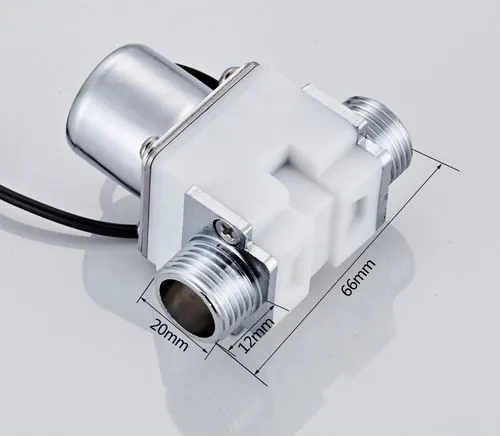Flush electromagnetic Valve working principle
< span style="font-size: 16px;">Solenoid valve in When not powered on, the metal core closes the central hole through the rubber pad under the action of the spring force at its upper end and automatic gravity, so that the water pressure in the water inlet chamber is equal to the water pressure in the sealing chamber between the rubber valve and the plastic pilot valve. Equally, the rubber valve is firmly pressed against the water pipe opening in the valve body, cutting off the water flow and ensuring the normal closing of the water inlet valve. When the solenoid valve is powered on, due to the action of electromagnetic force, the metal core is sucked up and the central hole is opened. At this time, the cavity pressure between the rubber valve and the plastic pilot valve is lower than the tap water pressure in the water inlet chamber. The rubber valve is pushed open, and the solenoid valve starts to inlet water.

The water inlet solenoid valve must meet two conditions for normal operation:
1. Corresponding power supply voltage 220v;
2. The pressure of tap water is guaranteed to be 0.01 Mpa—0.02Mpa. Normally, the water inlet volume of the solenoid valve is 3—25L/min.
The working principle diagram of the solenoid valve test system designed according to the solenoid valve product industry standards. The electrical control of the test system is mainly completed by PLC. The test system can provide a test water pressure of 0.01-0.08Mpa. The parts are manually placed using fixtures and pneumatic components. The solenoid valve automatically clamps and relaxes, and has functions such as automatically turning on and off power, water and air sources, automatically detecting the flow, leakage, startup and other properties of the solenoid valve, and automatically prompting and alarming. Each test parameter can be preset and adjusted to achieve digital display requirements of the solenoid valve's flow rate, coil current, and voltage. The test system has 5 test benches, 3 of which mainly complete the flow test when the voltage is 220V and the water pressure is 0.01Mpa, 0.1Mpa and 0.3Mpa respectively, and 1 mainly completes the flow test when the voltage is 1871V and the water pressure is 0.8Mpa. To test the startup characteristics, one unit completed leakage detection when the voltage was 220v and the water inlet pressure was 0.02Mpa and 0.08Mpa.
How to install the flush solenoid valve
1. Use pipe pliers to loosen the upper and lower nuts of the flush valve a few threads, then unscrew the water valve screws by hand, and remove the broken one. Flush solenoid valve.
2. Move the top Solenoid valve Wrap the outer teeth with raw material tape. When wrapping the raw material tape, it must be wrapped in the same direction and reversed, otherwise water will leak.
3. Rinse the wrapped raw material tape Use a pair of vise pliers to insert the upper end of the solenoid valve into the inner hole of the water inlet and tighten it. The water pipe wrench will not work. Then place a flat rubber pad on the water inlet and tighten the pipe wrench with your hands. When twisting, be sure to lay the rubber pad flat first, and then slowly tighten the nut. If the nut is not twisted properly, water will leak out.
4. After installation, look at the nuts above and below If there is no leakage, slowly adjust until there is no leakage and then gently tighten the screws.
The above isWorking principle of flushing solenoid valve, how to install flushing solenoid valve Content introduction, if you want For more information, please log in to www.diancifa.cc.






 WhatsApp: +8615857777578
WhatsApp: +8615857777578